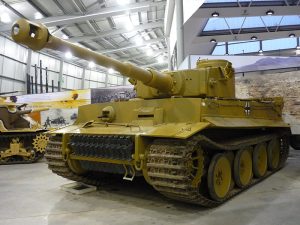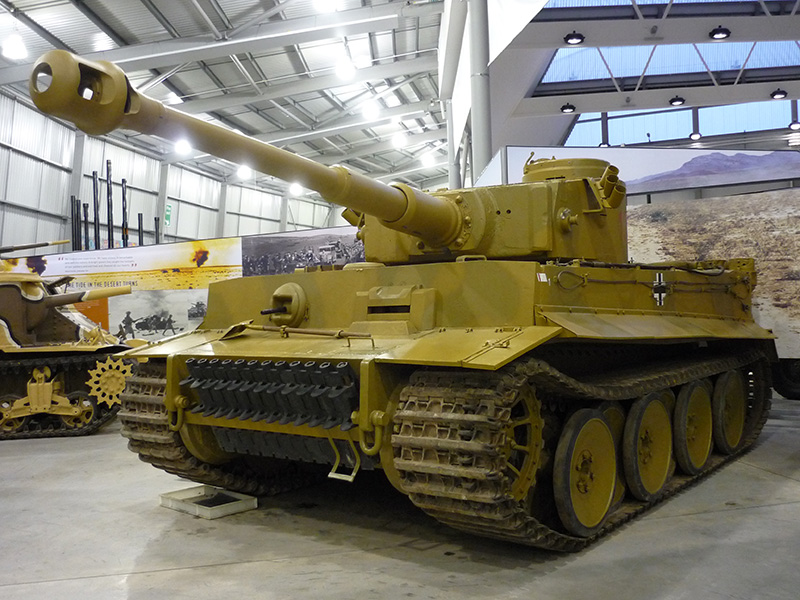The dangerous mission to capture a German Tiger tank during World War II was only recently revealed after Major Douglas Lidderdale’s death in 1999. Lidderdale, then, a young military engineer kept diaries about his time during the Second World War – discovered by his son after he passed away. It was only then that this secret mission was brought to light, but still not everyone knows about it – they should.
So gripping and revealing was his story that it was even made into a book in 2012, called ‘Catch That Tiger’, by Noel Botham and Bruce Montague with David Lidderdale. Lidderdale’s personal account details how he was given the mission to capture the enemy tank by Winston Churchill himself. In the underground Cabinet War Rooms the Prime Minister approached him and said:
“Mr Lidderdale. I’ve heard a lot about you. Pretty genned up on tanks are you not?” “Major, I want you to go and catch me a Tiger. “I want you to bring me a Tiger Tank. Park the bloody thing outside my front door. Do you understand?”
That was all Lidderdale needed to hear, and in January 1942 Douglas left with his hand picked team for Tunisia during the North Africa Campaign, where they met fierce fighting, along a 20-mile front.
Tigerphobia: One of the most feared tanks of World War Two
The German Tiger tank was not only heavily armoured but it was also highly protected with powerful weapons on board. This made it one of the most feared tanks of World War Two and it gained an invincible reputation. It was reported that the Tigers on one day destroyed 100 Allied tanks and dozens of men burned to death after being hit by the Tigers’ powerful and accurate guns.

The deadly 60-tonne German tanks were wiping out British soldiers, and subsequently destroying Allied morale. Terror of Tigers was so widespread it had its own nickname, ‘Tigerphobia’. In order to learn how to defeat them in battle, Churchill knew he had to get hold of one, and he trusted Lidderdale with this crucial mission. The months rolled on in Tunisia for Lidderdale and he and his team kept having near misses – one Tiger was blown up by the Royal Engineers, a second was towed to safety by the German army, and another was destroyed by its crew to stop it being captured. Day after day he experienced the destruction of the Tigers, first hand, and risked his own life constantly. After all the near misses he became increasingly frustrated. However, persistence and patience paid off and the chance to capture a Tiger finally came…
Bagged one!
On April 21, 1943, there were around 250,000 enemy troops gathered in north-east Tunisia. The Allies were just a day away from forcing the enemy to surrender, but the Germans got wind of the plans and launched a surprise attack! This was what Lidderdale had been waiting for and turning to Reg, he said: “You can bet your life that among them are Tigers on the prowl. This could be our lucky day, the chance to nab one at last.” They set off in a Churchill Mark IV tank and headed to the battlefield. Lidderdale told his team: “We must spot one that’s in trouble and pounce.” It didn’t take long to spot an opportunity and less than half a mile away from them was the turret of a Mark VI Tiger, 131, which was jammed. The hatch was open and a soldier was examining one of the tank’s guns. Lidderdale and his team made their way towards the Tiger at top speed and opened fire, peppering the German with bullets – this, apparently was the first time Lidderdale had shot a man. With their own tank alongside the Tiger, Lidderdale climbed onto the roof, but the mission was far from complete. As he tried to keep his balance, one of the German crew emerged with an MP 40 machine gun… But, then one of Lidderdale’s team opened fire on the German in the nick of time. “Gentlemen I propose a toast. To the capture of the Tiger – Herr Hitler’s favourite toy,” said Lidderdale.
A few weeks later, Churchill came to see the tank for himself and said: “One day Mr Lidderdale, the nation will know all about the courage of you and your men. But you must not talk about this mission until I give you the word.”
A 6-pounder solid shot from a Churchill tank of the British 48th Royal Tank Regiment hit the Tiger’s gun barrel and ricocheted into its turret ring, jamming its traverse and wounding the commander. The crew bailed out and the tank was captured”
Getting the beast home
The mission was still not completely over though, and Douglas had to set about transporting the Tiger back to Britain. The Germans knew this and were determined to stop him. He successfully got the Tiger on the SS Empire Candida cargo ship for the first leg of the journey but a Germans U-boat opened fire. According to the accounts, Douglas then used the German’s own weaponry against them and turned the Tiger’s guns on the submarine. He missed but the U-boat retreated. In September, 1943, during darkness, he drove the tank on to the foredeck of the Ocean Strength, armed with a Fairbairn-Sykes fighting knife and service revolver. Liderdale took no chances and in case the ship came under attack he also ordered 60 life rafts, one for each tonne of his Tiger.
“Winston Churchill wants this tank,” he told his men. “And by God, I’m going to deliver it to him.”
It was a hairy journey getting the tank home to ‘Blighty’ and along the way the ship was pursued by U-Boats and Luftwaffe planes, but eventually in October 1943 the tank arrived in Glasgow before it got taken to London. Douglas went on to use the Tiger’s technology to develop war machines for the D-Day landings which ultimately changed the course of the war.
Christmas come early
Delivering the rather hefty present to the Prime Minister and completing his mission in that October of 1943 must have been particularly satisfying for Lidderdale. Churchill greeted him: “Mr Schicklgruber (Hitler) and his Huns will be crying themselves to sleep tonight. Thank you, Colonel.” “Thank you sir but if I may say so, with respect, I’m only a major,” Douglas said. “With respect, I think you can call yourself Colonel after this,” replied the Prime Minister. The Tiger 131 now has pride of place at Bovington Tank Museum in Dorset.
Revealing the war heroes in your family
Do you know enough about your ancestors who fought in the First World War? Why not log on to Forces War Records and find out more – there could be a war hero in your family just waiting to be discovered, and remembered…
Source: Mirror


